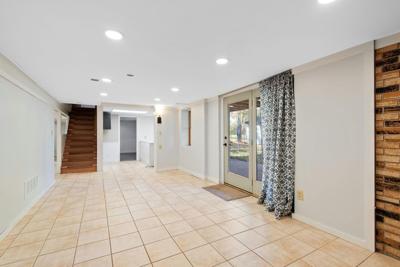
Basements have a reputation for being dark, damp, and musty, but with the right approach, you can turn yours into a fresh, comfortable space. Whether you're looking to create a cozy home theater, a home gym, or just some extra storage, keeping moisture at bay is the key to avoiding mold and making your basement truly livable.
Here’s how to get rid of the damp, fight off mold, and transform your basement into a dry, welcoming oasis.
Why Do Basements Get So Damp?
Basements naturally attract moisture because they sit underground, where they’re surrounded by soil that retains water. Add in poor ventilation, leaks, and condensation from temperature differences, and you’ve got the perfect recipe for mold growth.
Mold thrives in damp environments, so if moisture is left unchecked, it can damage your walls, floors, and belongings while also creating serious health risks.
Keep Water Out with Waterproofing
Before you think about finishing or furnishing your basement, make sure it's protected from water intrusion. Inspect your foundation walls and floor for cracks or gaps where water might sneak in. Even small cracks can become major problems over time.
Use a high-quality waterproofing sealant to coat your basement walls and floors. This helps keep moisture from seeping through porous concrete.
If you get frequent water buildup, a sump pump can help move water away from your home’s foundation, preventing flooding and moisture buildup.
Make sure your gutters and downspouts are directing water at least six feet away from your home. Poor drainage around your foundation can lead to persistent basement moisture issues.
For a more in-depth solution, interior basement waterproofing is a great option. It can help redirect water away from your foundation and prevent moisture problems before they start.
Control Humidity Like a Pro
Even if your basement isn’t visibly wet, high humidity levels can create a breeding ground for mold. Ideally, your basement’s humidity should stay below 50%.
Use a dehumidifier. This is one of the simplest ways to maintain the right humidity levels in your basement. Choose a model with a built-in humidistat to keep moisture levels in check.
Improve airflow in your basement. Stagnant air leads to condensation, which can feed mold growth. If your home’s basement has windows, make sure that you crack them open sometimes. If not, install vents or fans to promote circulation.
If your basement is connected to your home’s HVAC system, make sure the vents are open to allow conditioned air to circulate. A small exhaust fan can also help pull humid air out.
Be Smart About Basement Finishing Materials
If you’re planning to turn your basement into a functional living space, you’ll need to be strategic about the materials you use.
Standard drywall can soak up moisture like a sponge. Look for moisture-resistant drywall, often called "green board," to keep your walls mold-free.
Opt for waterproof flooring. Carpet in a basement is usually a bad idea - it absorbs moisture and traps mold. Instead, go for:
Vinyl planks
Porcelain tile
Ceramic tile
Sealed concrete
For a durable, moisture-resistant surface.
Traditional fiberglass insulation can trap moisture and encourage mold growth. Instead, go for closed-cell spray foam or rigid foam board insulation, which won’t absorb water.
If you're using wood materials, make sure they're properly sealed to prevent moisture damage.
Keep an Eye on Your Plumbing
Even with waterproofing and humidity control, an unnoticed plumbing leak can quickly turn your basement into a moldy mess. Inspect pipes regularly. Check for leaks, drips, or condensation on your pipes, especially around joints and fittings.
Wrap pipes in insulation. Cold pipes can cause condensation, leading to water droplets forming on the surface.
Check your water heater. A slow leak from your water heater can go unnoticed for months. Keep an eye out for any pooling water or rust.
Be Diligent About Basement Maintenance
The key to keeping your basement mold-free isn’t just a one-time fix - it’s about consistent maintenance.
Even in the winter, basement humidity can creep up. Keep your dehumidifier running as needed.
Check for leaks after heavy rain. Walk around your basement after a storm to make sure no water has made its way in.
Keep clutter off the floor: Store items on shelves instead of directly on the basement floor, especially if they're made of fabric or cardboard. Mold loves to grow on organic materials.
If your basement has HVAC vents or exhaust fans, clean them regularly to prevent dust and mold buildup.
Transforming Your Basement Into a Comfortable Space
Once you’ve tackled moisture control, you can focus on making your basement feel like a true extension of your home. Use warm lighting, cozy furniture, and bright wall colors to offset the usual basement gloom. Area rugs (made of synthetic, moisture-resistant materials) can add warmth without the risks of full carpeting.
With the right approach, your basement can be a comfortable, stylish, and mold-free space that adds value and functionality to your home. Keep an eye on humidity levels, invest in proper waterproofing, and stay proactive with maintenance. That way, your basement oasis will stay dry and inviting for years to come.


(0) comments
We welcome your comments
Log In
Post a comment as Guest
Keep it Clean. Please avoid obscene, vulgar, lewd, racist or sexually-oriented language.
PLEASE TURN OFF YOUR CAPS LOCK.
Don't Threaten. Threats of harming another person will not be tolerated.
Be Truthful. Don't knowingly lie about anyone or anything.
Be Nice. No racism, sexism or any sort of -ism that is degrading to another person.
Be Proactive. Use the 'Report' link on each comment to let us know of abusive posts.
Share with Us. We'd love to hear eyewitness accounts, the history behind an article.